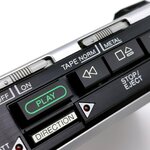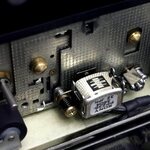 WM-16WM-6 twin
WM-16WM-6 twin

WML ID #16
- Manufacturer
- Sony
- Model
- WM-16
- Nick
- WM-6 twin
- Year
- 1983
- Made in
- Japan
- Initial price
- 21000 ¥Today 282 $
Technical details, specifications
- Battery
- 2AA
- Battery life
- 5h (with 2)
- Colors
- gray (matte) white red
- Dimensions
- 138*87*34 mm (408 cm³)3D size
- Weight
- 320 gr
- Window
- yes
- Frame
- plastic
- Case
- metal
- Carry
- belt
- Expandable
- no
- External compartment
- no
- Head
- PP238-3604 3Z JPN
- Tape selector
- Manual switch
- Waterproof
- no
- Speaker
- no
- Frequency range
- 40-15000@1,@2,@4 Hz
- FMax output
- 2x18 mW
Functions
- DC in
- yes
- Record by input
- no
- Record by int mic
- no
- Hotline mode
- no
- Cue
- no
- Balance (L/R)
- no
- Phone type
- 1
- Equalizer
- no
- Auto reverse
- yes
- Anti rolling
- no
- Logic control
- no
- Hold lock
- no
- Bass
- no
- Noise reduction
- Dolby System
- Radio
- no
- Remote control
- no
- Wireless headphone
- no
- Indicator
- led
Description
This early auto-reverse model followed the WM-7/WM-17, but was simpler and cheaper.
This early auto-reverse model followed the WM-7, but was simpler and cheaper. This could be seen in its larger size and plastic, as opposed to metal, casework. Many key features were kept: along with auto reverse, Dolby B NR, LED direction indicator and chrome/metal tape compatibility. Removed were the remote control and the logic-operated tape transport controls. Although more affordable than the WM-7, the WM-6 was by no means in the “budget” class. It still cost over twice as much as the cheapest model, the WM-22.
In contrast to the WM-7, two extra motors, a special rotating switch and complex electronic logic circuit for auto reverse arrangement, the WM-6 was simple, using only a solenoid coil and a couple of transistors. The mechanical layout was unusual though, in that the head was on the opposing side of the deck to the tape transport buttons, something that was not obvious from a casual glance at the outside.
While the WM-6 worked well on the whole, the simplified mechanism had some drawbacks. The main was that it returned to the forward direction after pressing stop key or after use of fast forward or rewind. This made finding a track on the second side of the tape difficult; one had to remember to press the reverse button after each winding operation. In an attempt to get around this, the designers included “cue” and “review” modes which did not require the play mode to be disengaged, though of course then the winding keys did not latch and the sound from the fast moving tape would have been deafening if the volume had not been turned down first.
The WM-6 was not perfect, but it showed how auto reverse could be simplified and included on Walkmans other than the very top line models. Soon this feature would become widespread across the range.Via Walkman Central (edited)












No comments yet